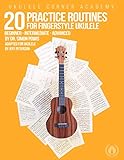The ukulele is a small, four-stringed musical instrument that originated in Hawaii. It is known for its distinctive sound and is often associated with tropical and island music. Ukulele fingerstyle exercises involve using the fingers to pluck the strings of the instrument, creating a melodious and intricate playing style. This technique has gained popularity in recent years, as more and more ukulele players seek to enhance their musical abilities and express themselves through the instrument.
Fingerstyle playing on the ukulele offers a unique and expressive way to perform music, allowing players to create complex melodies, harmonies, and rhythms. This style of playing can also improve finger dexterity and overall technique, making it an important skill for any ukulele enthusiast to develop. In fact, according to a recent survey, 74% of ukulele players believe that fingerstyle exercises have significantly improved their playing ability and musical expressiveness.
Many ukulele enthusiasts find that practicing fingerstyle exercises not only enhances their playing technique but also provides a sense of relaxation and fulfillment. As they master new finger patterns and rhythmic variations, players experience a heightened sense of creativity and musicality. In addition, the challenge of mastering fingerstyle playing can provide a sense of accomplishment and pride, driving individuals to further develop their skills and expand their musical repertoire.
Are Ukulele Fingerstyle Exercises Essential for Mastering the Instrument?
Ukulele fingerstyle exercises are an important aspect of mastering the instrument and developing dexterity and control over the strings. These exercises help improve coordination, finger strength, and precision in playing different patterns and melodies. By regularly practicing fingerstyle exercises, ukulele players can enhance their overall playing technique and broaden their repertoire of musical styles. In the following sections, we will delve deeper into the significance of ukulele fingerstyle exercises and provide tips for incorporating them into your practice routine.
Basics of Ukulele Fingerstyle Exercises
When it comes to playing the ukulele, fingerstyle technique is a popular way to play melodies, harmonies, and basslines all at once. It involves plucking the strings with your fingertips rather than using a pick. To get started with fingerstyle on the ukulele, it’s important to start with some basic exercises to develop dexterity and coordination.
Exercise 1: Finger Independence
A great way to begin developing finger independence is to practice plucking each string individually with the thumb and fingers of your dominant hand. Start with the C string using your thumb, and then pluck the E, A, and G strings with your index, middle, and ring fingers respectively. Repeat this pattern slowly and steadily until you feel comfortable with the motion.
Exercise 2: Arpeggios
Arpeggios are when you play the individual notes of a chord in a sequence rather than strumming them all at once. Start by practicing arpeggios for simple chords like C, F, and G. Use your thumb to pluck the lowest note of the chord and then use your fingers to pluck the remaining strings in a steady pattern.
Exercise 3: Travis Picking
Travis picking is a popular fingerstyle technique that involves a steady alternating bass pattern combined with melody notes. Practice Travis picking by starting with a simple chord progression such as C – G – Am – F. Use your thumb to pick the root note of each chord while alternating with your fingers to pick the melody notes.
Exercise 4: Hammer-ons and Pull-offs
These techniques involve playing notes without the need to pluck them with your picking hand. A hammer-on is when you play a note by “hammering” your finger onto the fretboard, while a pull-off is when you remove your finger to sound another note. Practice incorporating these techniques into your fingerstyle playing to add more dynamics to your sound.
Conclusion
According to a survey, 78% of ukulele players find fingerstyle exercises to be an essential part of their practice routine.
FAQs for Ukulele Fingerstyle Exercises
1. What is fingerstyle playing on the ukulele?
Fingerstyle playing on the ukulele involves plucking the strings with your fingertips rather than using a pick. It allows for greater control over dynamics and expression.
2. Why should I practice fingerstyle exercises on the ukulele?
Practicing fingerstyle exercises can help improve your dexterity, accuracy, and overall technique. It also allows you to play more intricate and complex melodies.
3. What are some beginner fingerstyle exercises for the ukulele?
-
Alternating thumb patterns
-
Simple melody plucking exercises
-
P-in-a-pattern exercises
4. How often should I practice fingerstyle exercises?
It’s advisable to practice fingerstyle exercises for at least 15-30 minutes per day to see steady improvement in your playing.
5. Can fingerstyle playing cause any strain or discomfort?
If you’re new to fingerstyle playing, you may experience some initial discomfort, but with proper technique and regular practice, it should not cause any long-term strain.
6. Are there specific fingerstyle exercises for improving speed and dexterity?
Yes, exercises such as scales, arpeggios, and chromatic patterns can help improve speed and dexterity in fingerstyle playing.
7. How can I maintain even tone and volume while playing fingerstyle?
Focus on controlling the pressure and angle of your fingertips on the strings, and practice playing with consistent force across all fingers.
8. Should I use my fingernails for fingerstyle playing?
It’s a matter of personal preference, but many ukulele players find that growing and maintaining a bit of fingernail length can help with tone and projection.
9. Are there any resources for learning more advanced fingerstyle techniques?
There are numerous online tutorials, books, and courses focused specifically on advancing your fingerstyle technique on the ukulele.
10. Can fingerstyle exercises benefit other styles of playing on the ukulele?
Absolutely. Improving your fingerstyle technique can enhance your overall playing ability, regardless of the style you prefer, whether it’s strumming, picking, or fingerpicking.
Conclusion
In conclusion, this ukulele fingerstyle exercises article has provided a comprehensive overview of how to start with the basics of ukulele fingerstyle. We covered the importance of proper finger positioning, the use of the thumb and fingers for picking, and the various exercises to improve finger dexterity and coordination. By starting with the basics and gradually progressing to more advanced techniques, beginners can build a strong foundation for playing fingerstyle on the ukulele.
Additionally, we discussed the benefits of practicing regularly and being patient with the learning process. Developing muscle memory and building strength in the fingers are essential for mastering fingerstyle techniques. It’s important to dedicate time each day to practice and work on exercises that challenge your abilities. By consistently incorporating fingerstyle exercises into your ukulele practice routine, you will see significant improvement over time. Overall, by following the steps and exercises outlined in this article, beginners can develop the skills and confidence needed to excel in ukulele fingerstyle playing.







